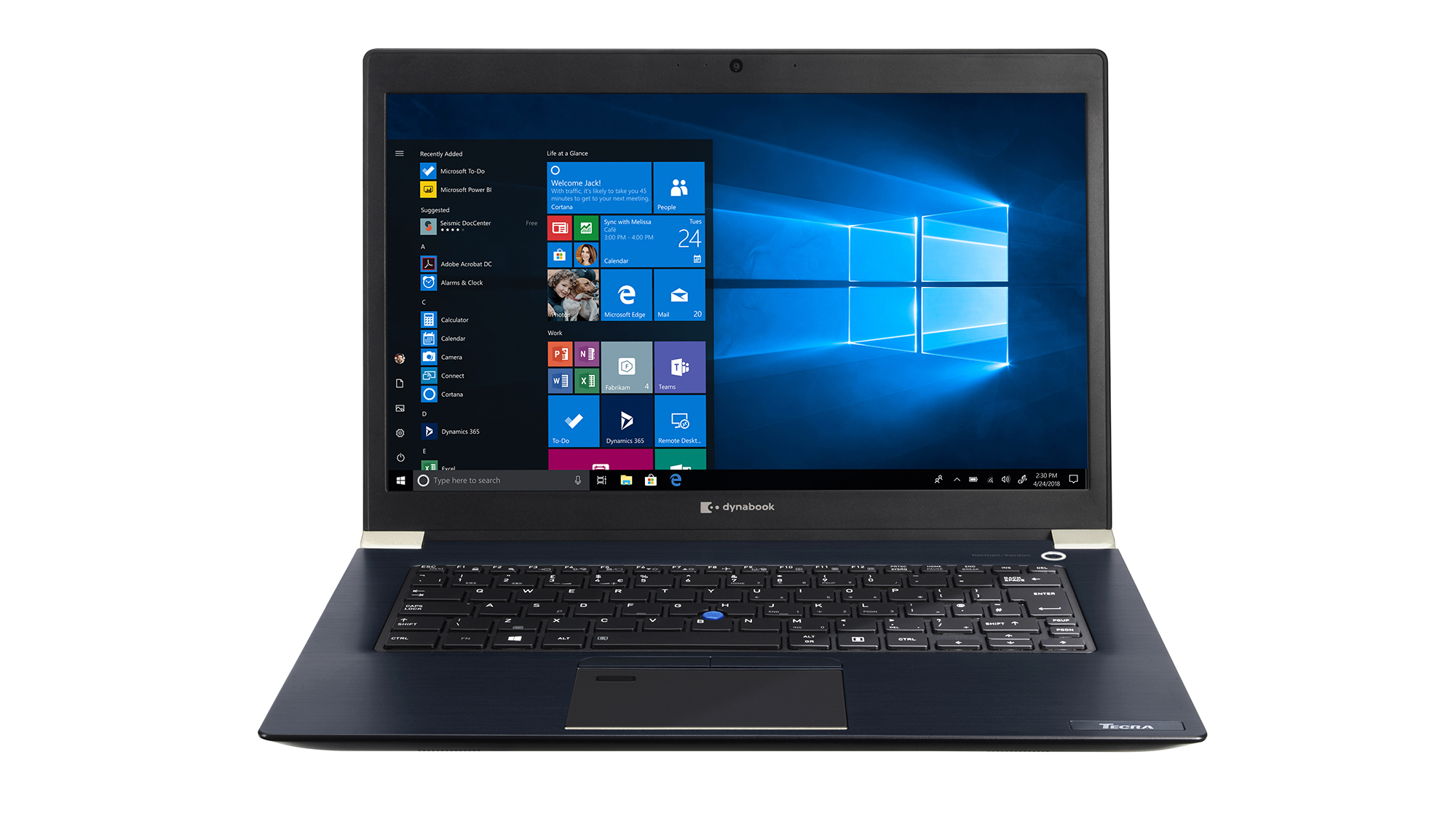Dynabook Tecra X40-F review: A solid county batsman
There’s nothing special about this middle-order laptop, but that’s kind of the point: it’s a safe choice for businesses

-
+
Solid portability
-
+
Good complement of ports
-
+
Enterprise-friendly features
-
-
Middling performance and battery life

The Tecra has been a stalwart of Toshiba’s business laptop range for years, with the promise of stoic reliability, solid specifications and – in corporate terms at least – an affordable price. Think of it as the dependable Michael Atherton of business laptops. Now that Dynabook has taken over the Toshiba laptop reins, it will be hoping for much of the same from the Tecra range.
There’s little to get excited about at first glance. The Tecra comes in the onyx blue, full magnesium chassis that’s fast becoming a Dynabook trademark, but without the ultra-slim dimensions of the Portégé range, this will never draw gasps from passers-by. Rather than come-to-bed eyes, this laptop has come-to-the-boardroom eyes.
At 1.25kg, it’s surprisingly light, and while a height of 16.9mm is a millimetre or two thicker than the ideal, its footprint of 332 x 229mm means it won’t consume much room in a briefcase. That’s an A4 sheet of paper, with an extra inch or so added to its width.
Dynabook also wins for its selection of ports. Rather than the stingy one USB-C port we often see, it has two Thunderbolt 3 USB-C ports: they’re both on the right edge, where you’ll also find a full-size HDMI port and a microSD slot. The left is more modestly dressed, with a USB 3 port, 3.5mm jack and Kensington lock.
Dynabook resists the temptation of squeezing in a numberpad, and that feels like the right choice: it means you can type with your hands in a central position. Anyone who types in quiet environments will love the keyboard, which provides plenty of travel on the keys without the loud click of some rivals. There are no weird layout decisions to worry about, although it may take you a little time to get used to the tiny PgUp and PgDn keys, and the shortened arrow keys at the bottom-right of the keyboard.
A trackpoint sits in the middle of the keyboard, along with mouse buttons below the spacebar, but most people will default to the smooth trackpad. Note the fingerprint reader embedded in it, although if you have any sense you’ll sign up to Windows Hello via the excellent and speedy IR camera: with support for Microsoft’s Modern Standby, this wakes the Tecra completely the moment you open the screen.
This brings us to bezel size. Dynabook doesn’t even try to follow the trend of ultra-slim edges, with a top bezel that measures 2cm: that’s huge by today’s standards. Dynabook told us that it needs this space for the Wi-Fi antennas (note that the radio uses the older 802.11ac standard, not the newer 802.11ax), but there’s surely room for improvement here.
Sign up today and you will receive a free copy of our Future Focus 2025 report - the leading guidance on AI, cybersecurity and other IT challenges as per 700+ senior executives
In particular, it would have been nice to squeeze in a slightly larger panel with a higher resolution. As Dynabook is 80% owned by Sharp, this is the kind of innovation we can hope to see in the future. Here, though, it’s still a Toshiba-made screen, and it’s not great. We measured a peak brightness of 320cd/m2 and contrast ratio of 1,114:1, which are fine, but sRGB gamut coverage of 55.4% and an average Delta E of 4.62 are surprisingly poor.
In real-world use, there are plus points to this display. Dynabook adds an anti-reflective layer that diffuses overhead lights, so many office workers will prefer this machine to others with superior technical results. It’s a ten-point touchscreen, too; while this is of limited benefit on a non-convertible, it’s still a useful navigation aid.
Dynabook sent us the top-end version of the Tecra X40-F, which will only be available by special request, which means it came stuffed with 32GB of RAM, a 1TB SSD and a Core i7-8565U. If you’re expecting spectacular performance, you’ll be disappointed: a score of 81 puts it in the middle of the pack for a laptop with a Core i7-8565U processor.
Nor should you expect stellar battery life. The 48Whr battery lasted for 7hrs 15mins in our video-rundown tests, so it’s a good thing the charger is relatively small and that you can recharge this laptop via the USB-C ports.
These mediocre results are a shame, but there are plenty of other things here that will appeal to corporate buyers: vPro processors, a BIOS that lets you take full control of the ports, MIL-STD-810G testing and the option of upgrading the single-year EMEA warranty to four years of international cover for £60.
So where does this leave the Tecra? To continue the cricket analogy, it’s a sturdy, middle-order, county-level batsman. No one will pay to come and watch it play, but it should be a reliable member of your first XI for years.
Dynabook Tecra X40-F specifications
| Processor | Quad-core 1.8GHz Intel Core i7-8665U processor |
| RAM | 32GB 2,400MHz DDR4 RAM |
| Additional memory slots | N/A |
| Graphics adapter | Intel UHD 620 Graphics |
| Storage | 1TB M.2 PCIe SSD |
| Screen size (in) | 14in |
| Screen resolution | 1,920 x 1,080 |
| Screen type | IPS display |
| Touchscreen | Yes |
| Pointing devices | Touchpad, trackpoint |
| Optical drive | N/A |
| Memory card slot | MicroSD slot |
| 3.5mm audio jack | Combo 3.5mm mic/headphone |
| Graphics outputs | 2 x Thunderbolt 3 (with data transfer, charging and DisplayPort support), HDMI |
| Other ports | USB 3 |
| Web Cam | 720p HD webcam |
| Wi-Fi | 2x2 802.11ac Wi-Fi |
| Bluetooth | Bluetooth 5 |
| NFC | N/A |
| Dimensions, mm (WDH) | 332 x 229 x 16.9mm |
| Weight (kg) - with keyboard where applicable | 1.25kg |
| Battery size (Wh) | 48Wh |
| Operating system | Windows 10 Pro |
Tim Danton is editor-in-chief of PC Pro, the UK's biggest selling IT monthly magazine. He specialises in reviews of laptops, desktop PCs and monitors, and is also author of a book called The Computers That Made Britain.
You can contact Tim directly at editor@pcpro.co.uk.
-
 Qualcomm the data center with $2.4 billion Alphawave Semi acquisition
Qualcomm the data center with $2.4 billion Alphawave Semi acquisitionNews The move sees Qualcomm absorb Alphawave Semi’s portfolio of custom silicon, high-speed connectivity solutions, and chiplets
By Daniel Todd Published
-
 ‘If software development were an F1 race, these inefficiencies are the pit stops that eat into lap time’: Why developers need to sharpen their focus on documentation
‘If software development were an F1 race, these inefficiencies are the pit stops that eat into lap time’: Why developers need to sharpen their focus on documentationNews Poor documentation is a leading frustration for developers, research shows, but many are shirking responsibilities – and it's having a huge impact on efficiency.
By Ross Kelly Published
-
 OpenAI says GPT-5.2-Codex is its ‘most advanced agentic coding model yet’ – here’s what developers and cyber teams can expect
OpenAI says GPT-5.2-Codex is its ‘most advanced agentic coding model yet’ – here’s what developers and cyber teams can expectNews GPT-5.2 Codex is available immediately for paid ChatGPT users and API access will be rolled out in “coming weeks”
By Ross Kelly Published
